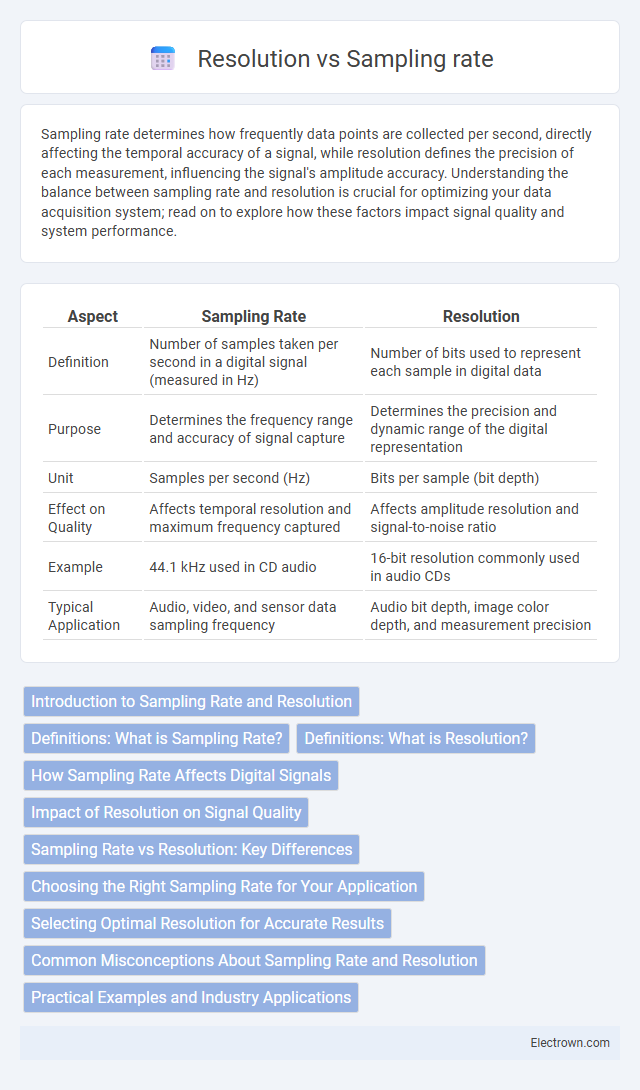Sampling rate determines how frequently data points are collected per second, directly affecting the temporal accuracy of a signal, while resolution defines the precision of each measurement, influencing the signal's amplitude accuracy. Understanding the balance between sampling rate and resolution is crucial for optimizing your data acquisition system; read on to explore how these factors impact signal quality and system performance.
Table of Comparison
| Aspect | Sampling Rate | Resolution |
|---|---|---|
| Definition | Number of samples taken per second in a digital signal (measured in Hz) | Number of bits used to represent each sample in digital data |
| Purpose | Determines the frequency range and accuracy of signal capture | Determines the precision and dynamic range of the digital representation |
| Unit | Samples per second (Hz) | Bits per sample (bit depth) |
| Effect on Quality | Affects temporal resolution and maximum frequency captured | Affects amplitude resolution and signal-to-noise ratio |
| Example | 44.1 kHz used in CD audio | 16-bit resolution commonly used in audio CDs |
| Typical Application | Audio, video, and sensor data sampling frequency | Audio bit depth, image color depth, and measurement precision |
Introduction to Sampling Rate and Resolution
Sampling rate defines the number of samples captured per second in digital audio or imaging, measured in Hertz (Hz), directly affecting the accuracy of signal representation. Resolution refers to the bit depth or the amount of detail each sample holds, determining the dynamic range and precision of the recorded data. Higher sampling rates improve the frequency range, while increased resolution enhances the signal's granularity and quality.
Definitions: What is Sampling Rate?
Sampling rate refers to the number of samples of an analog signal taken per second to convert it into a digital signal, measured in Hertz (Hz). It determines how frequently the audio or video signal is sampled, directly affecting the accuracy and quality of the digital representation. Higher sampling rates capture more detail but require greater data storage and processing power.
Definitions: What is Resolution?
Resolution refers to the number of distinct values a digital system can represent, typically measured in bits, which determines the precision of signal quantization. Sampling rate, measured in Hertz (Hz), defines how many samples per second are taken from a continuous signal to convert it into a digital format. While sampling rate affects the frequency range captured, resolution impacts the amplitude accuracy and detail of the digital representation.
How Sampling Rate Affects Digital Signals
Sampling rate directly impacts the accuracy of digital signals by determining how frequently the analog signal is measured per second, typically expressed in Hertz (Hz). Higher sampling rates capture more data points, reducing aliasing and preserving signal detail, which is crucial for audio fidelity and precise waveform reproduction. Your choice of sampling rate affects the quality and clarity of the digital signal, influencing applications from music production to telecommunications.
Impact of Resolution on Signal Quality
Higher resolution in digital audio recording significantly enhances signal quality by capturing more detailed amplitude variations, resulting in a more accurate and nuanced representation of the original sound. Resolution, measured in bits, determines the dynamic range and the smallest detectable signal variation, directly influencing the clarity and depth of your audio. Increasing bit depth reduces quantization noise, enabling richer sound reproduction and better preservation of subtle audio details.
Sampling Rate vs Resolution: Key Differences
Sampling rate determines how frequently audio samples are captured per second, measured in Hertz (Hz), affecting the frequency range and detail you can hear. Resolution, expressed in bits, defines the amplitude precision of each sample, influencing the dynamic range and clarity of sound. Higher sampling rates capture more sound information, while higher resolution improves audio accuracy, both crucial for professional audio quality.
Choosing the Right Sampling Rate for Your Application
Selecting the appropriate sampling rate depends on the frequency range and accuracy required for your application, with higher sampling rates capturing more detail and reducing aliasing. Resolution determines the precision of each sample, influencing the signal's amplitude accuracy but not its temporal fidelity. Balancing sampling rate and resolution ensures optimal data quality while managing storage and processing demands effectively.
Selecting Optimal Resolution for Accurate Results
Selecting the optimal resolution is critical for achieving accurate results in data acquisition and digital signal processing. Higher sampling rates capture more detailed information, reducing aliasing effects and preserving signal integrity, while an appropriate bit resolution ensures precise amplitude representation of your measurements. Balancing sampling rate and resolution based on the specific characteristics of the signal enables you to optimize data quality and system performance.
Common Misconceptions About Sampling Rate and Resolution
Sampling rate often gets confused with resolution, but they represent distinct concepts in digital audio and imaging. Sampling rate defines how frequently data points are captured per second, impacting temporal accuracy, whereas resolution refers to the precision or detail within those captured data points, such as bit depth in audio or pixel count in images. Misinterpreting these terms can lead to incorrect assumptions, like believing a higher sampling rate improves image detail, which is actually a factor of resolution.
Practical Examples and Industry Applications
Sampling rate determines how frequently an analog signal is measured per second, essential for applications like audio recording where 44.1 kHz sampling captures CD-quality sound. Resolution defines the number of discrete values each sample can have, influencing image sensors where 12-bit or 16-bit depth enhances color accuracy in digital photography. In medical imaging, high sampling rates combined with high resolution improve MRI scan clarity, while industrial automation relies on precise sampling and resolution for accurate sensor data in quality control.
Sampling rate vs Resolution Infographic

 electrown.com
electrown.com